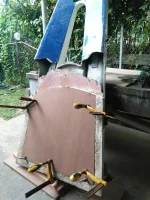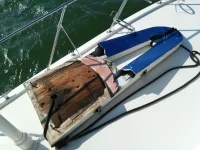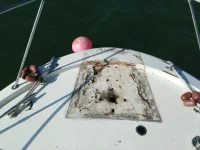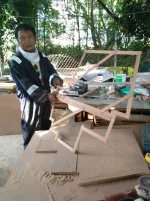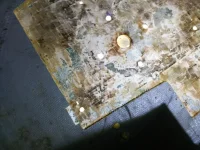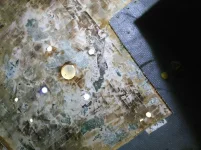Triskele
Well-known member
- Joined
- Nov 16, 2012
- Messages
- 264
- Status
- OWNER - I own a Hatteras Yacht
- Hatteras Model
- 43' DOUBLE CABIN (1970 - 1984)
Spent the last few nights reading through most of the threads on this forum about repairing/replacing the deck core and watching some youTube videos on same. Really found the thread "Galley Maid Windlass Removal" (repairs done by Dan Mapes) helpful and informative. Bought my 43 DCMY four years ago and at the time it surveyed for moisture on the deck and had soft spots around the bow pulpit, above the chain locker and down the starboard gunwale to the wing doors. It was my intention at the time of purchasing the boat, and still is, to have this breach repaired. The time has now arrived. Since I consider the return on my time from doing the repair myself to be of far greater value than most boat yards place on their time, I will be doing the work myself. (In other words, the $$$$ savings (and visceral experience...satisfaction) I will gain doing the work myself far exceeds the benefit of over paying a boat yard. There has been much back and forth on this forum about the pros/cons of DIY versus farming it out to ruthless mercenaries so I don't see the sense of going there (since you can probably guess my opinion). Suffice it to say, that I am doing it myself and don't wish to be persuaded otherwise. Having said that, I am well aware of the undertaking and my limitations. When the time comes, I will be happy to pay for a FAIR days work. Not the extortionist wages of the yards.
Now to the point. Where I am at at this stage is deciding whether to attack it from the bottom or the top. Based upon comments from his thread, and experience with his own project, Dan Mapes would vote for bottom. However, I have seen others who have taken it on from the top (pealed back the skin) on much bigger projects with success. And perhaps therein lies the difference. Correct me if I am wrong, but in Dan's case (sorry Dan, not picking on you) it was his first project and it was limited to the area forward the bulkhead and above the chain locker (an area that was relatively clear and approachable from the bottom and didn't require removing the headliner among other things). In other examples, it involved removing the core from an entire deck with an experienced crew (see Cap'n Bilgewater video on youTube...https://www.youtube.com/watch?v=QUk4O8YFun4). In that case, they went at it from the top.
After first reading through Dan's thread and following his progress and solutions to attacking from the bottom, I was a convert. However, after more thought and others input, I am not so sure that working from the bottom is right for my situation. Since, I also have issues along the gunwale and intend to repaint the deck, it probably makes sense to go in from the top on my project. Then as well, perhaps there is an arguement for a two pronged approach. Going in from the bottom to repair the area under the bow pulpit and over the rode locker, and also going in from the top to repair the area to the starboard wing under the walkway along the gunwale. Then finish up with a nice resurfacing of the deck. The problem with this is that if you are going to resurface the deck (always like answering my own questions) then shouldn't you go ahead and just remove the bow pulpit and finish that area from the top as well?
So here are my pros/cons of both approaches. Let me know what you think and anything else I may have left out in my analysis.
Bottoms Up:
Pros - don't have to remove the bow pulpit, don't need to resurface (won't be pulling up the outer skin), no need to repaint. For the inexperienced, any skrew ups are more easily corrected (hidden).
Cons - working in a rather tight and confined space, possibly messier for the inexperienced (think dripping epoxy...gravity works against you), need to build a "scaffold" to hold in place molds/jigs.
Top Down:
Pros - ease of access, hopefully less mess (can pour epoxy onto top of bottom layer (gravity works in your favor).
Cons - cutting into and pealing back the outer layer. The need to be skilled at laying fiber glass, fare, sand and repaint the outer layer. Have to remove the bow pulpit and perhaps other deck hardware. Although, I am under cover, in some cases, you will be exposed to the elements in which case you will have to work fast to avoid exposing the new core to moisture.
IMHO...for small jobs (under 2 sq ft), I would argue for drilling a few holes from the bottom (if accessible), vacuum the water/moisture out, let dry, seal and then go in from the top and syringe in a sealer such as "Git-Rot" or an epoxy to harden the "dried" core in place (without removing), seal it up and resurface the area. For medium jobs (defined as > 2 sq. ft., but < 5 or 6 sq.ft), working from the bottom seems to make sense if you have the access. For larger jobs (and on large vessels >36 ft?...after all this is a Hatteras Forum and there are very few Hatteras' under 36 feet that I am aware of), I don't see how you can get around not lifting the top skin and attacking the core depending on the amount of rot. (Full disclosure...again, this is my opinion based upon what I have learned to date through researching the subject. I have no experience to speak from.)
Thoughts? Feedback?
Look forward to hearing from you. Once I get started, will try to keep an online diary in this forum of my experience and progress.
Jay
Now to the point. Where I am at at this stage is deciding whether to attack it from the bottom or the top. Based upon comments from his thread, and experience with his own project, Dan Mapes would vote for bottom. However, I have seen others who have taken it on from the top (pealed back the skin) on much bigger projects with success. And perhaps therein lies the difference. Correct me if I am wrong, but in Dan's case (sorry Dan, not picking on you) it was his first project and it was limited to the area forward the bulkhead and above the chain locker (an area that was relatively clear and approachable from the bottom and didn't require removing the headliner among other things). In other examples, it involved removing the core from an entire deck with an experienced crew (see Cap'n Bilgewater video on youTube...https://www.youtube.com/watch?v=QUk4O8YFun4). In that case, they went at it from the top.
After first reading through Dan's thread and following his progress and solutions to attacking from the bottom, I was a convert. However, after more thought and others input, I am not so sure that working from the bottom is right for my situation. Since, I also have issues along the gunwale and intend to repaint the deck, it probably makes sense to go in from the top on my project. Then as well, perhaps there is an arguement for a two pronged approach. Going in from the bottom to repair the area under the bow pulpit and over the rode locker, and also going in from the top to repair the area to the starboard wing under the walkway along the gunwale. Then finish up with a nice resurfacing of the deck. The problem with this is that if you are going to resurface the deck (always like answering my own questions) then shouldn't you go ahead and just remove the bow pulpit and finish that area from the top as well?
So here are my pros/cons of both approaches. Let me know what you think and anything else I may have left out in my analysis.
Bottoms Up:
Pros - don't have to remove the bow pulpit, don't need to resurface (won't be pulling up the outer skin), no need to repaint. For the inexperienced, any skrew ups are more easily corrected (hidden).
Cons - working in a rather tight and confined space, possibly messier for the inexperienced (think dripping epoxy...gravity works against you), need to build a "scaffold" to hold in place molds/jigs.
Top Down:
Pros - ease of access, hopefully less mess (can pour epoxy onto top of bottom layer (gravity works in your favor).
Cons - cutting into and pealing back the outer layer. The need to be skilled at laying fiber glass, fare, sand and repaint the outer layer. Have to remove the bow pulpit and perhaps other deck hardware. Although, I am under cover, in some cases, you will be exposed to the elements in which case you will have to work fast to avoid exposing the new core to moisture.
IMHO...for small jobs (under 2 sq ft), I would argue for drilling a few holes from the bottom (if accessible), vacuum the water/moisture out, let dry, seal and then go in from the top and syringe in a sealer such as "Git-Rot" or an epoxy to harden the "dried" core in place (without removing), seal it up and resurface the area. For medium jobs (defined as > 2 sq. ft., but < 5 or 6 sq.ft), working from the bottom seems to make sense if you have the access. For larger jobs (and on large vessels >36 ft?...after all this is a Hatteras Forum and there are very few Hatteras' under 36 feet that I am aware of), I don't see how you can get around not lifting the top skin and attacking the core depending on the amount of rot. (Full disclosure...again, this is my opinion based upon what I have learned to date through researching the subject. I have no experience to speak from.)
Thoughts? Feedback?
Look forward to hearing from you. Once I get started, will try to keep an online diary in this forum of my experience and progress.
Jay

